The best thing about the ROG Xbox Ally X is that it finally acknowledges the truth – a truth that, despite continued denials by device after device, at least partly accounts for why the little old Steam Deck still rules the world of handheld PCs despite being slower and lower-rez than almost everything that followed it. You know it, I know it, and at last, Microsoft know it: Windows 11 just isn’t that good as a handheld OS.
Thus, the biggest upgrade that the ROG Xbox Ally X – and its little brother, the ROG Xbox Ally – makes is not to its hardware, but the software. Instead of booting straight into the Windows 11 desktop, a miserable experience when your only navigational tools are thumbsticks and a touchscreen, it defaults to a far more gamepad-optimised (and specifically gaming-focused) ‘Xbox’ mode that provides quick, D-paddable access to your choice of launchers and the games installed within. Yes. Great. Cool. Big fan. I still wouldn’t buy one.
The fact that it costs £800 (or a crisp $1000 in the US) doesn’t help, but then the MSI Claw 8 AI+ already proved that it can be worth splashing out if framerates and practicality are up to premium standards. The ROG Xbox Ally X sometimes makes the cut, though is just as often outpolished or outlasted by its peers, and even suffers from outright faults that undermine Asus and Microsoft’s genuinely good UX work.
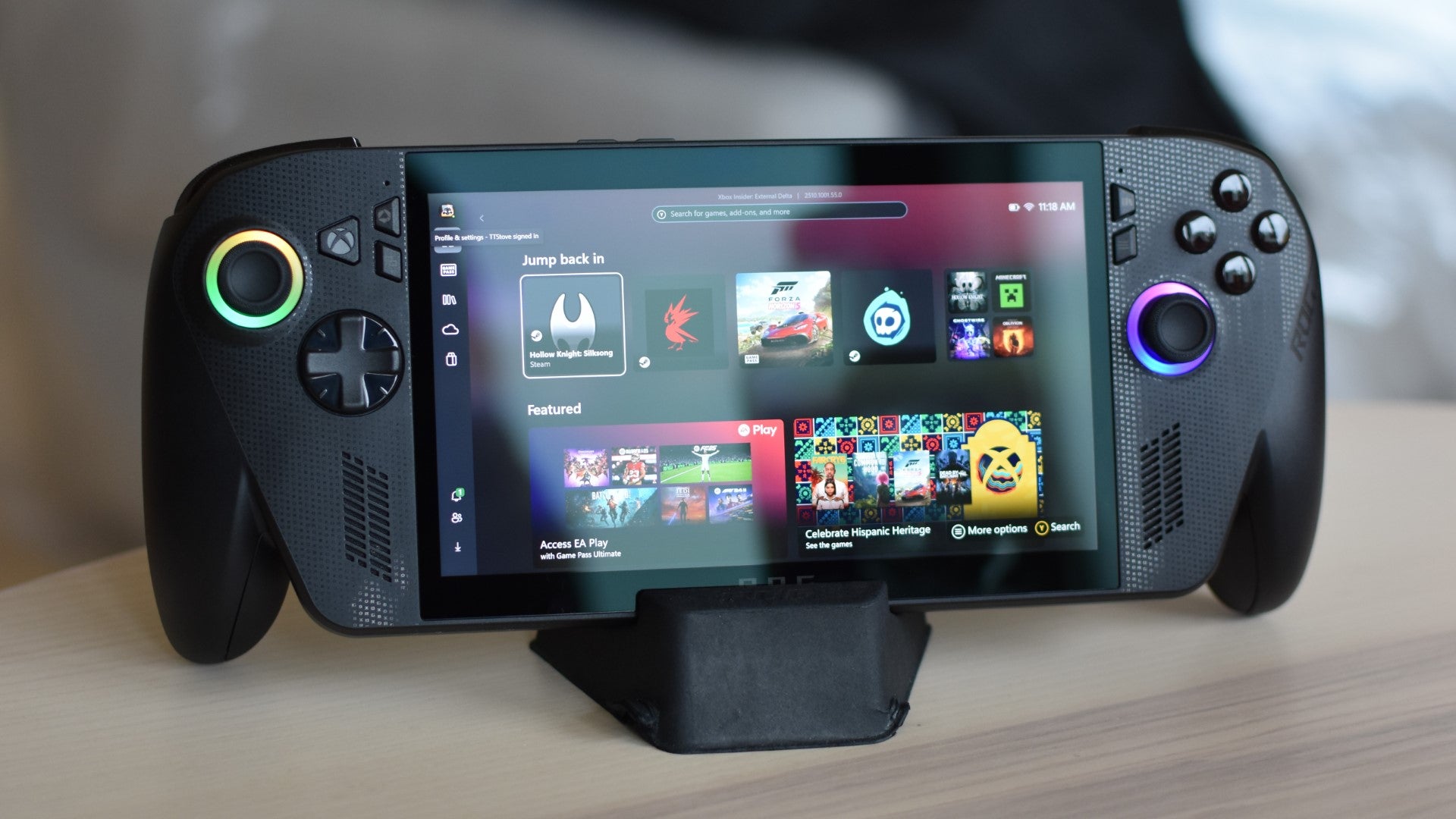
While those efforts focused on making the operating system more comfortable, the ROG Xbox Ally X still aims to please your hands. The protruding, controller-style grips are a vast ergonomic improvement on the meagre bumps of the original ROG Ally and ROG Ally X, and the thumbsticks keep the taut, grippy design of the latter. In another instance of feature-lifting from Xbox gamepads, the triggers contain independent rumble motors for more finely-tuned vibration feedback when you pull them. The list of supporting games isn’t amazingly long, but this did add a nice little finger-frisson to hurtling about in Forza Horizon 5.
It’s also not as heavy as it looks: at 715g it’s only a few dozen grams more than the Steam Deck OLED, and lighter than the Claw 8 AI+. The Claw does have an extra inch of diagonal screen estate, to be fair, and the height added by the ROG Ally X’s stick-out grips will impede on bag space, though keep it in the default Performance mode when on battery power and its cooling system isn’t anywhere near as noisy as the MSI’s.
All this apparent design proficiency, sadly, also serves to highlight when the ROG Xbox Ally X gets it wrong. The D-pad, for one, is a nasty little plate of cheap plastic, incongruous with the fine machining around it. And the face buttons, while functionally serviceable, emit an oddly pronounced percussive sound, giving the whole thing an antisocial noisiness regardless of whether you’ve got headphones plugged in. They’re loudest on the depress, so there’s little sense that this was an intentional attempt at delivering aural feedback, à la the clicky precision of Razer’s Wolverine V3 Pro controller.
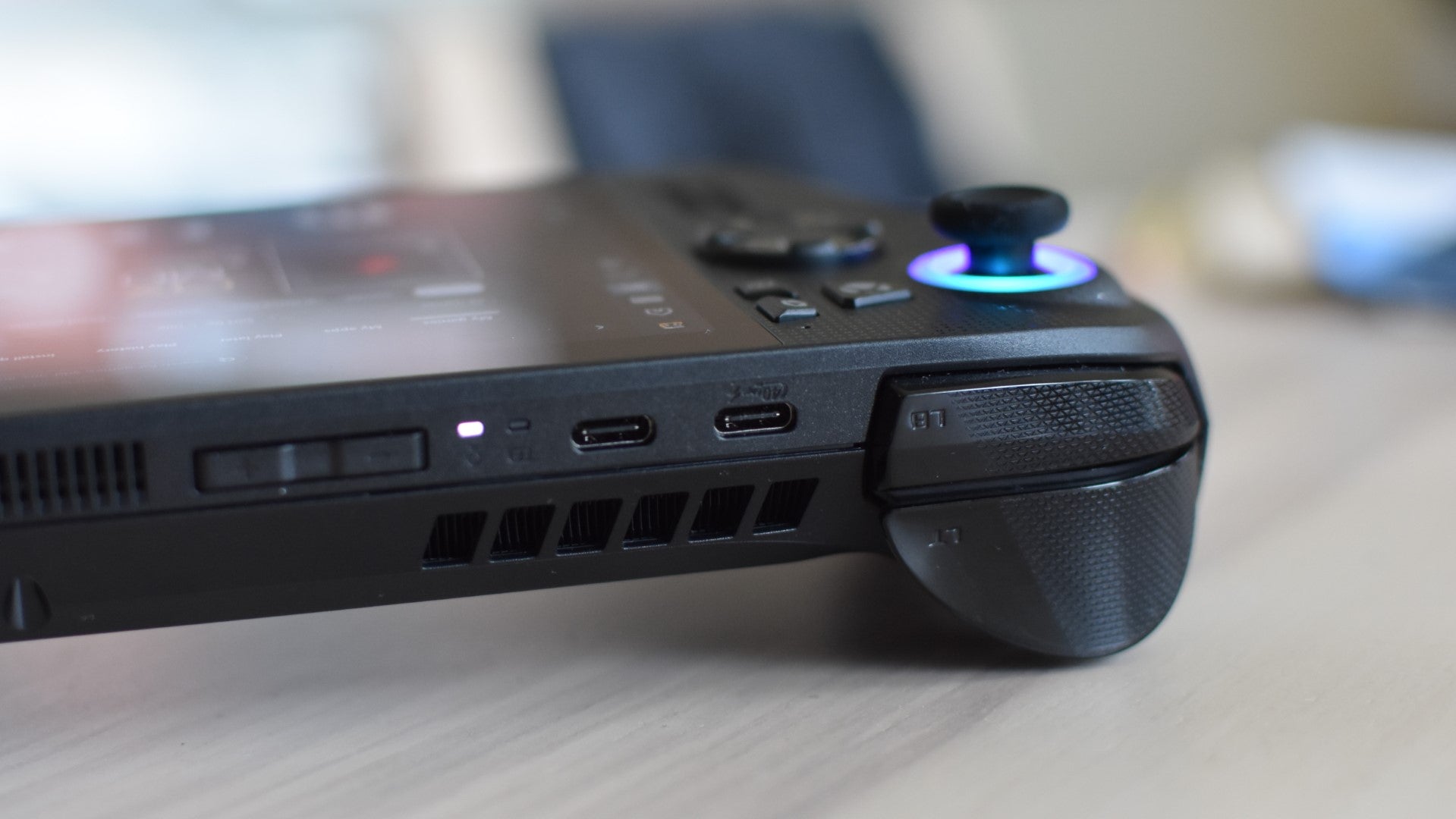
Worse, on a couple of occasions, the vibration motors in my test unit – first the right, then the left – decided they’d rather not work for a bit. Both malfunctions occured during otherwise uneventful Hollow Knight: Silksong sessions, when each motor suddenly ceased shaking and instead sent out naught but a shrill rasping sound, which I initially mistook as coming from the speakers. This persisted across other games until fixing itself on a system restart. That’s preferable to the motors breaking down permanently, but still, how many times is that going to happen on your brand-new £800 games machine?
The display, meanwhile, is a downgrade on the ROG Ally X’s. The Xbox-branded model sticks to a 7in, 1920×1080, 120Hz LCD panel, so it’s still sharper and faster than either Steam Deck variant. Yet it’s also slightly duller than its own predecessor, covering 94.6% of the sRGB gamut in my colourimeter tests versus the original Ally X’s 97.1% – meaning it can’t reproduce quite as many different colours. And although the contrast difference is much of a muchness, dropping ever-so-slightly from 1311:1 to 1306:1, there’s a much more noticeable reduction in peak brightness, with the ROG Xbox Ally X maxing out at 462cd/m2. That’s even less luminous than the very first, most basic ROG Ally, and only about half the nits that the Steam Deck OLED can blast through your corneae in HDR games.
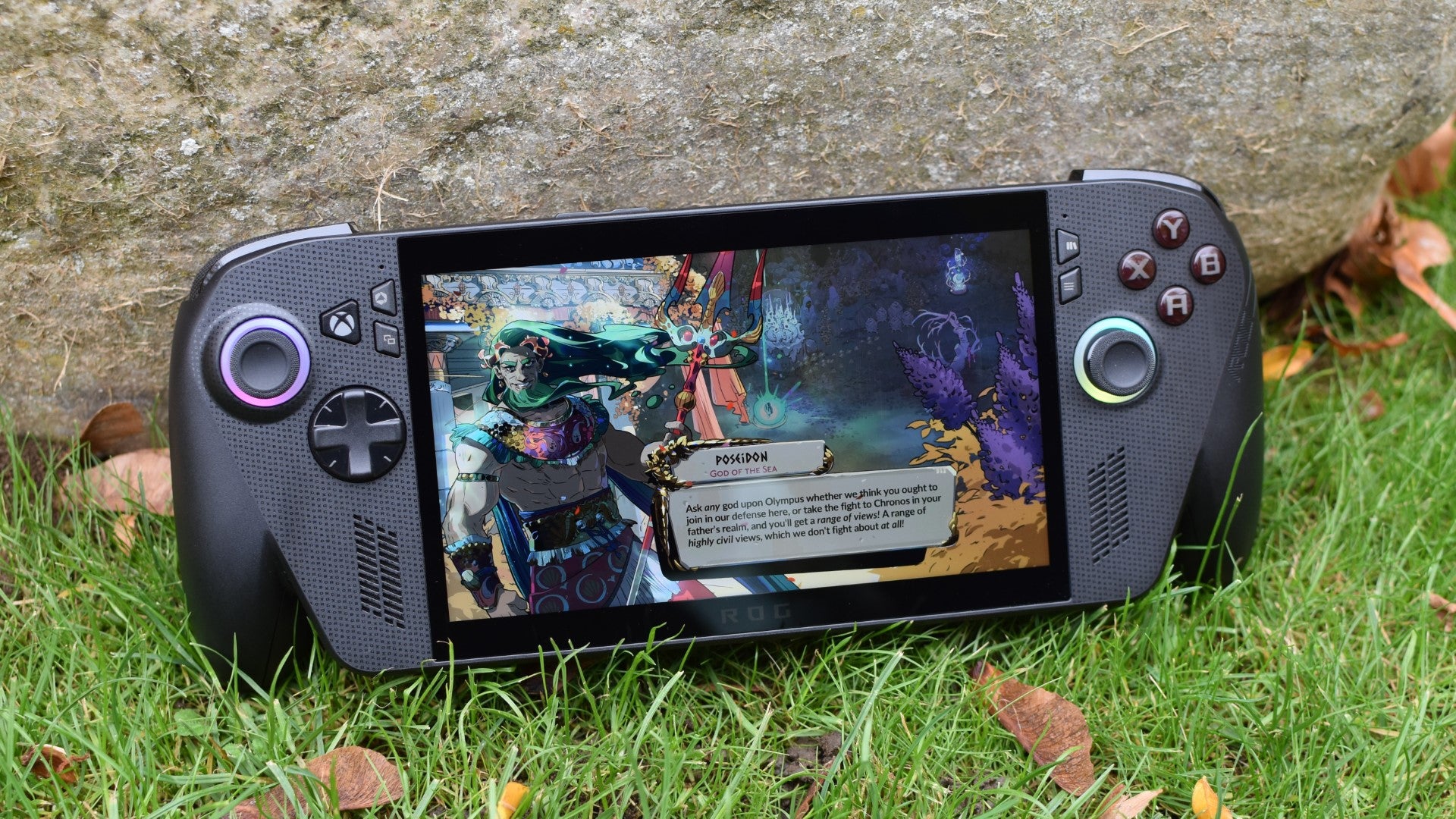
None of that is to say the screen looks like an old Nokia’s. It’s fine. It’s big enough, sharp without culling the battery via excessive resolution, and is at least bright enough to use in anything outside of direct, blazing sunlight. But it’s also no better, and in some ways is objectively worse, than the older, cheaper handheld it’s supposed to replace.
Games performance, at least, shows some progress. The ROG Xbox Ally X’s AMD Ryzen Z2 Extreme is a direct-as-you-like upgrade to the Ryzen APU that fueled previous Allies, and even with a disappointing result in Cyberpunk 2077, manages to thrash both in the standard Performance mode.
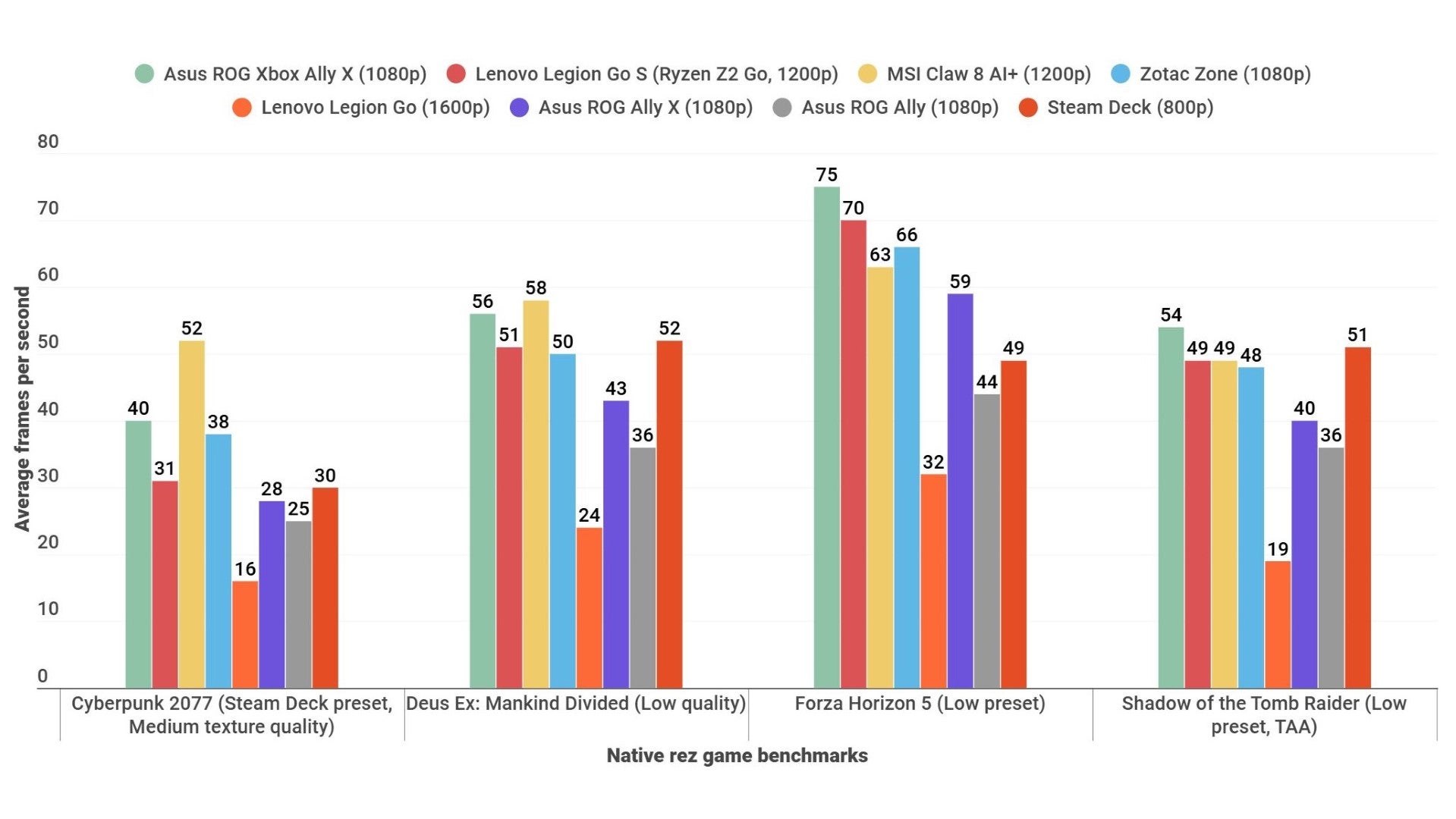
Its relationship with other, more recent high performers, namely the Claw 8 AI+ and the Zotac Zone, is more complex. While Asus’ latest comfortably wins out in Forza Horizon 5, it’s the MSI that best handles the more demanding Cyberpunk. It edges ahead of the ROG Xbox Ally X in Deus Ex: Mankind Divided as well, leaving Shadow of the Tomb Raider as merely a modest victory for the Asus x Microsoft collab.
It’s still a scrap after dropping to 1280×720, with the Zone – which I’ve just noticed has dropped from £850 to £499 in the year it’s been on sale – actually beating the ROG Xbox Ally X in half these games and effectively drawing with it in Shadow of the Tomb Raider. In short, the ROG Xbox Ally X is competitive with the other go-fast handheld PCs of its day – and is certainly quicker than any Steam Deck – but it’s not a truly next-gen gamechanger.
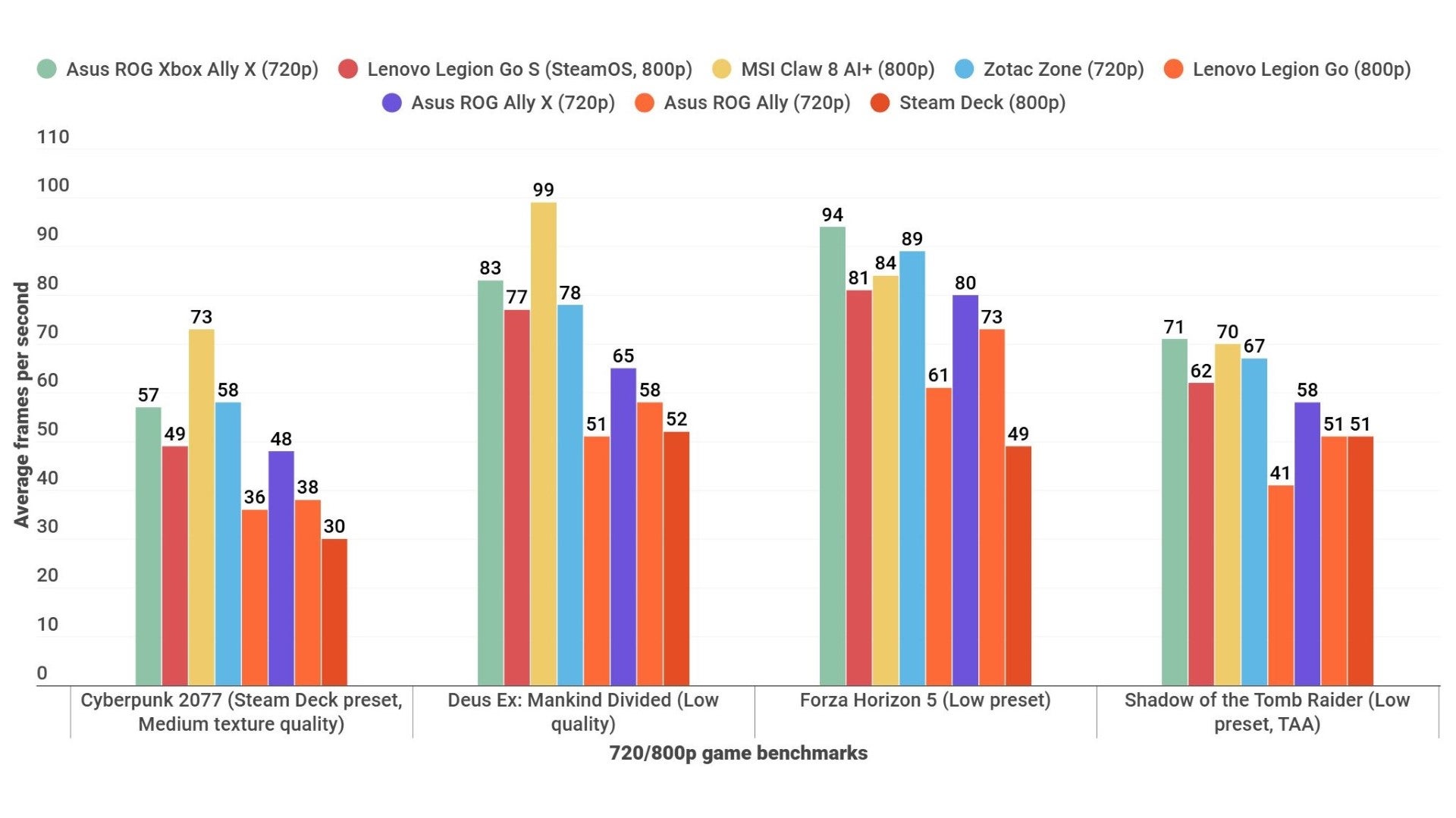
“Ah,” I blatantly fabricate you asking, “but what about that Xbox mode? Its lightweight, bloat-disabling version of the OS promises to optimise games performance like no other Windows handheld before it.” First off, all those results are from Xbox mode – it’s the default, and you need to manually switch to the full desktop mode. Second, it turns out that optimisation thing doesn’t pan out.
Here’s another, extended round of benchmarks, performed in both Xbox and traditional desktop modes:
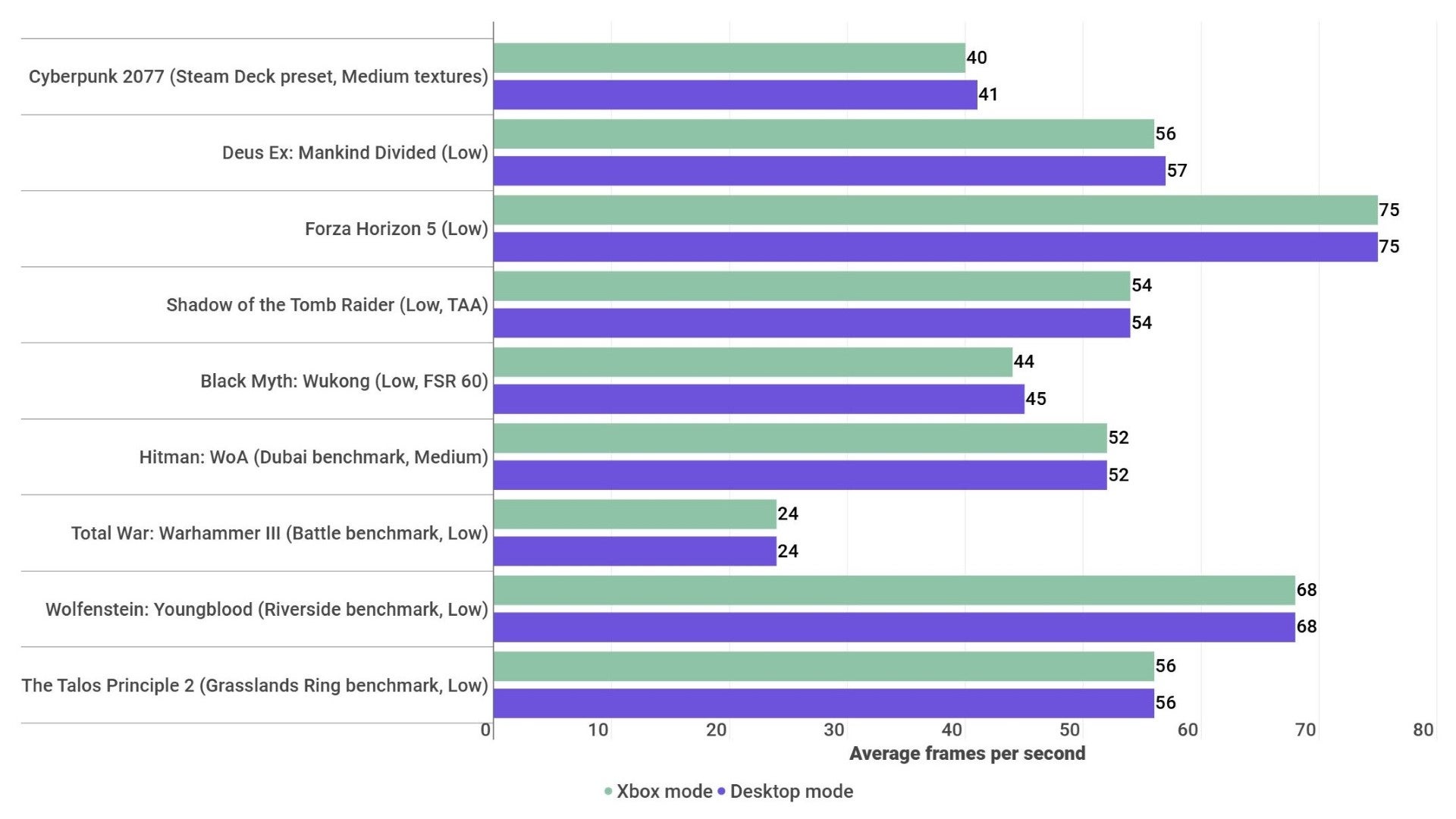
What this collection of identical bars shows – especially when desktop mode, not Xbox mode, earns a single extra frame – is that the ROG Xbox Ally X’s special interface is precisely that. An interface improvement, and a welcome one, but not something that can be relied upon to make your games run faster.
It’s inconsistent about helping out with battery life, too. In theory, Xbox mode’s lack of non-gaming background processes should save some juice, but I only saw this happen to a tiny degree in Portal 2, which drank the ROG Xbox Ally X dry in 2h 55m (again, using Performance mode) before switching to desktop mode and running out in 2h 50m. Forza Horizon 5, a first-party Xbox joint you’d think would work great here, in fact went the other way: it lasted 2h 45m in Xbox mode but 2h 51m in desktop mode. At best, that suggests there’s a margin of error in battery life to the tune of a few minutes, which in turn would make the Portal 2 result even more qualified.
There’s also the matter of both these results regressing slightly from the ROG Ally X’s battery scores, which were – under the same conditions of 50% screen brightness and 50% speaker volume – 2h 59m in Portal 2 and 2h 55m in Forza. The MSI Claw 8 AI+ beats it on average too, with 3h 22m and 2h 52m respectively. And once again, if it’s longevity you want, especially for less demanding games, nothing beats the Steam Deck OLED and its 5h 48m in Portal 2.
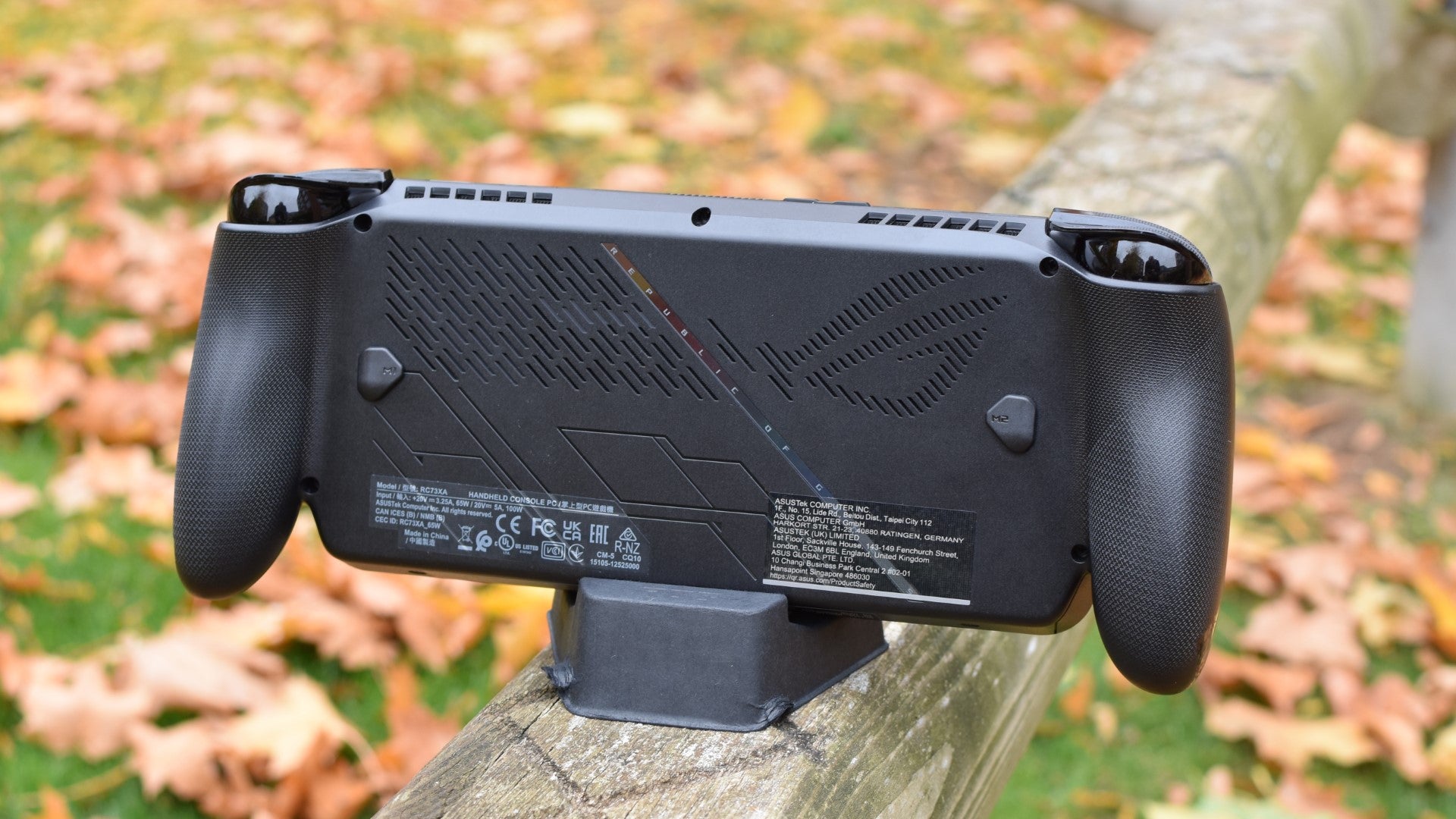
The lack of efficiency and display improvements do sometimes give the ROG Ally X an air of “Eh, good enough”, which is bizarre, because I can’t believe it was half-arsed as a whole. The shape of it, the melding of console controller features, all the Windows/Xbox stuff – this is all genuinely radical thinking for a handheld PC, a medium that’s been at risk of settling into routine after that initial burst of post-Steam Deck innovation and excitement.
Maybe Xbox mode doesn’t even need to act as an afterburner for games performance; it’s still good to have as an alternative to bodged cursor controls or poking at tiny Explorer windows with the touchscreen. The main view steers you, expectedly, to Microsoft’s own store and Game Pass offerings, but it graciously brings in shortcuts to recently played games on Steam, Epic, EA Play and so on, all right at the top when you switch on.
The launchers themselves are only a couple of presses away too, with the Xbox button on the left side whipping out a handy menu of shortcuts and settings. And I’m not sure if this counts as an OS or hardware improvement, but the ROG Ally X’s version of Quick Pause and Quick Resume works a lot more reliably than it has on… well, literally every Windows handheld I’ve used before. Previously it was far to common to put your device to sleep mid-game, return later, and find it’s kicked you back to the desktop – here, pausing with the power button is as safe as it is on a Steam Deck.
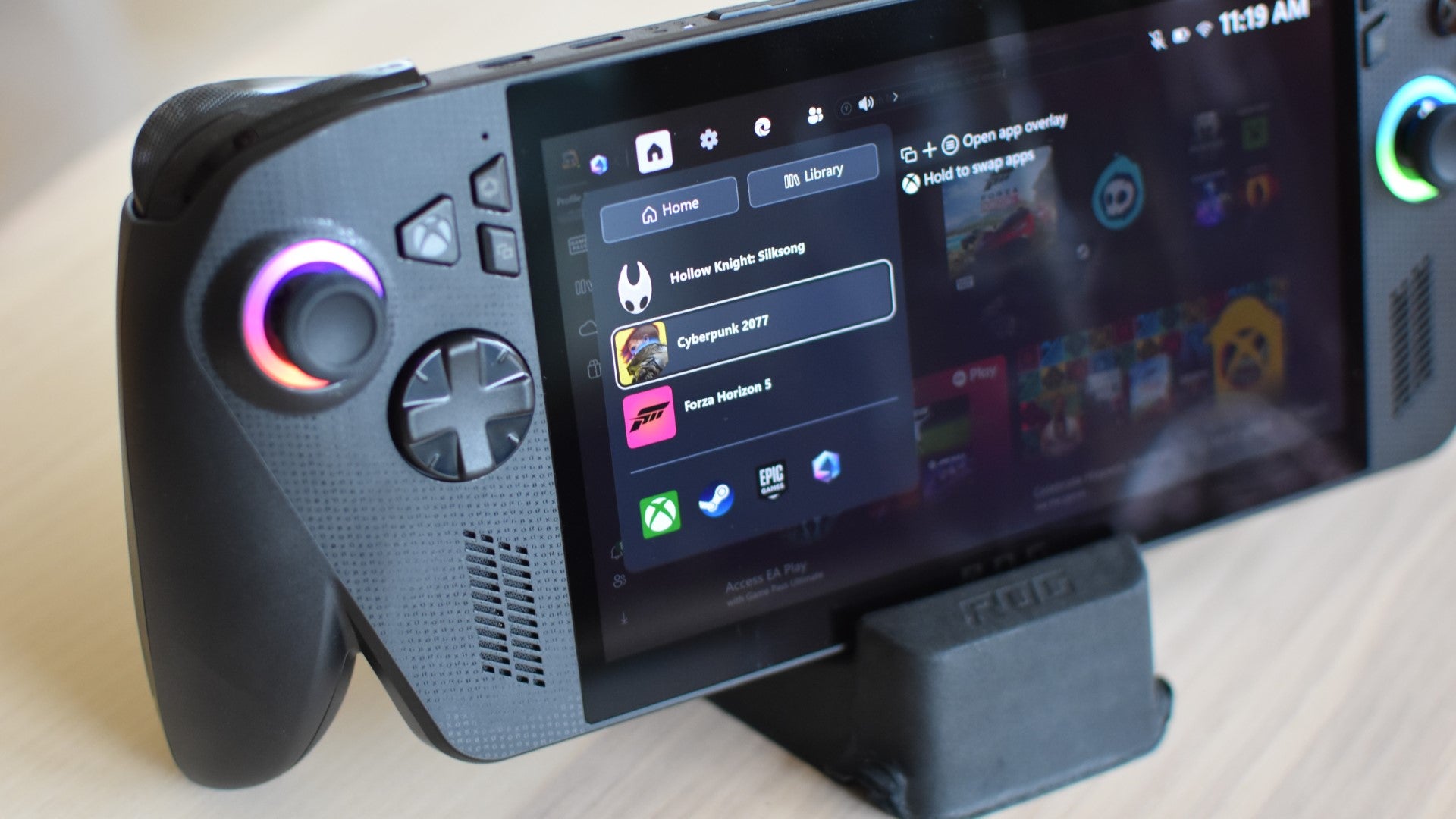
Sadly, like the vibration motors, even the headline-featuring OS rejig sometimes goes off-kilter. The gamepad-tuned interface is great but more often than not, Xbox mode simply won’t recognise thumbstick, D-pad, or face button inputs when you boot into it – I’ve had to tap the screen to essentially wake it up, upon which it remembers it’s supposed to be responding. It can also be sluggish when opening overlays, including basic functions like the onscreen keyboard, which I’ve repeatedly had to prod at multiple times before it starts accepting commands.
And, while non-Microsoft launchers are welcome, the ROG Ally X doesn’t really offer a solution for navigating these as effectively as the Xbox view. With the exception of Steam, which can be set to start in its SteamOS-style Big Picture mode, you’re once again the mercy of the touchscreen for apps that were designed for a mouse and keyboard. There’s no trackpad and, at least on its default settings, the ROG Ally X no longer provides a cursor to nudge around with the right thumbstick, so installing and launching games through something like the Epic Games Store is as slow and fiddly as it would be on any other Windows portable.
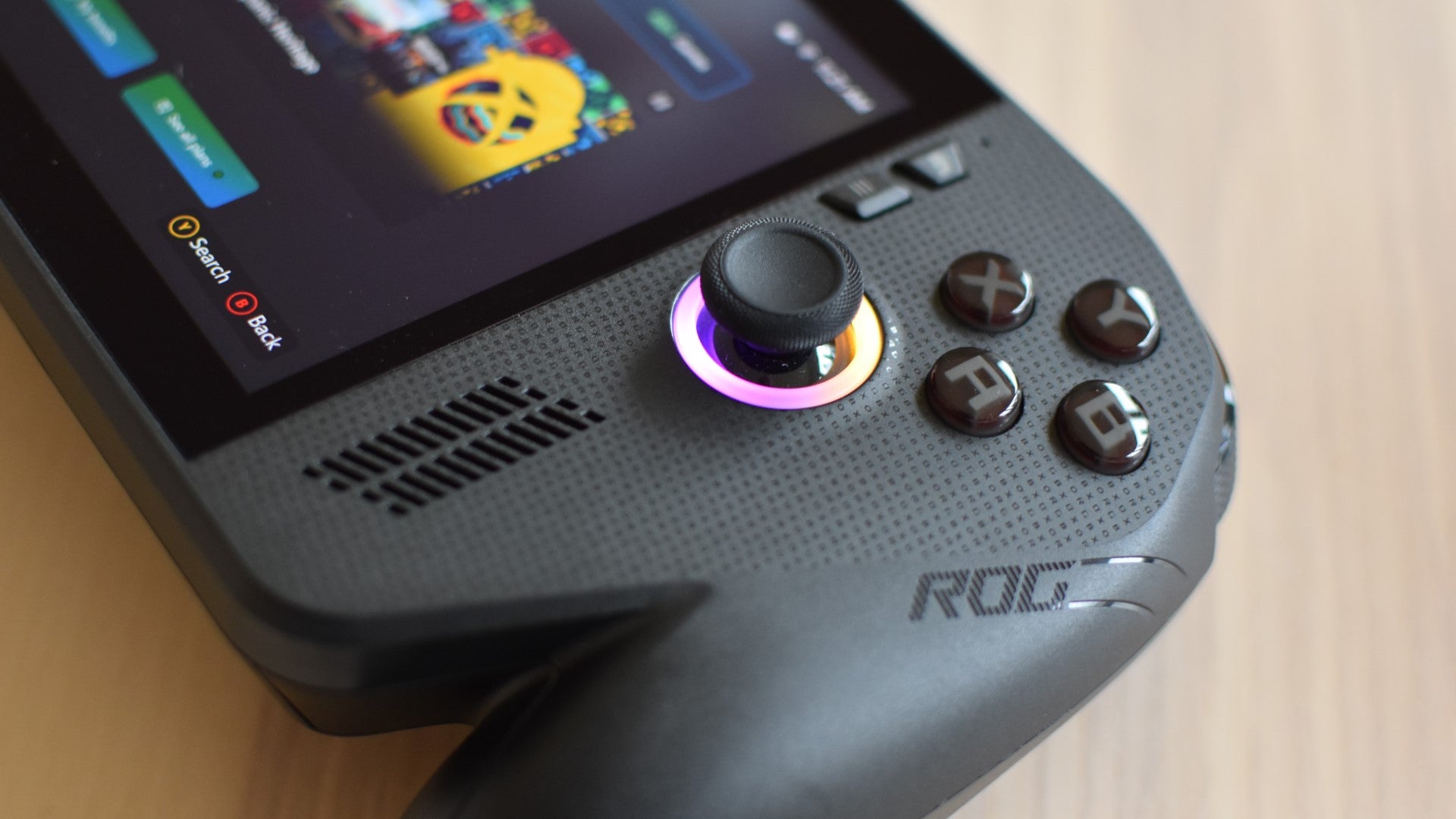
While it stumbles in the right direction, then, the ROG Ally X never fully lives up to the promise of being a truly tailored Windows 11 handheld. I don’t want to put that entirely on Xbox mode’s shortcomings, because ultimately the interface (and general, sofa-splayed gameplaying experience) is better than that of vanilla Windows.
But then, I don’t have to. There are enough other reasons – the underwhelming screen, the middling battery life, the aggravating face button noise, the price, and especially the temperamental vibration – to give this handheld a miss. Or, at the very least, wait for some fixes.